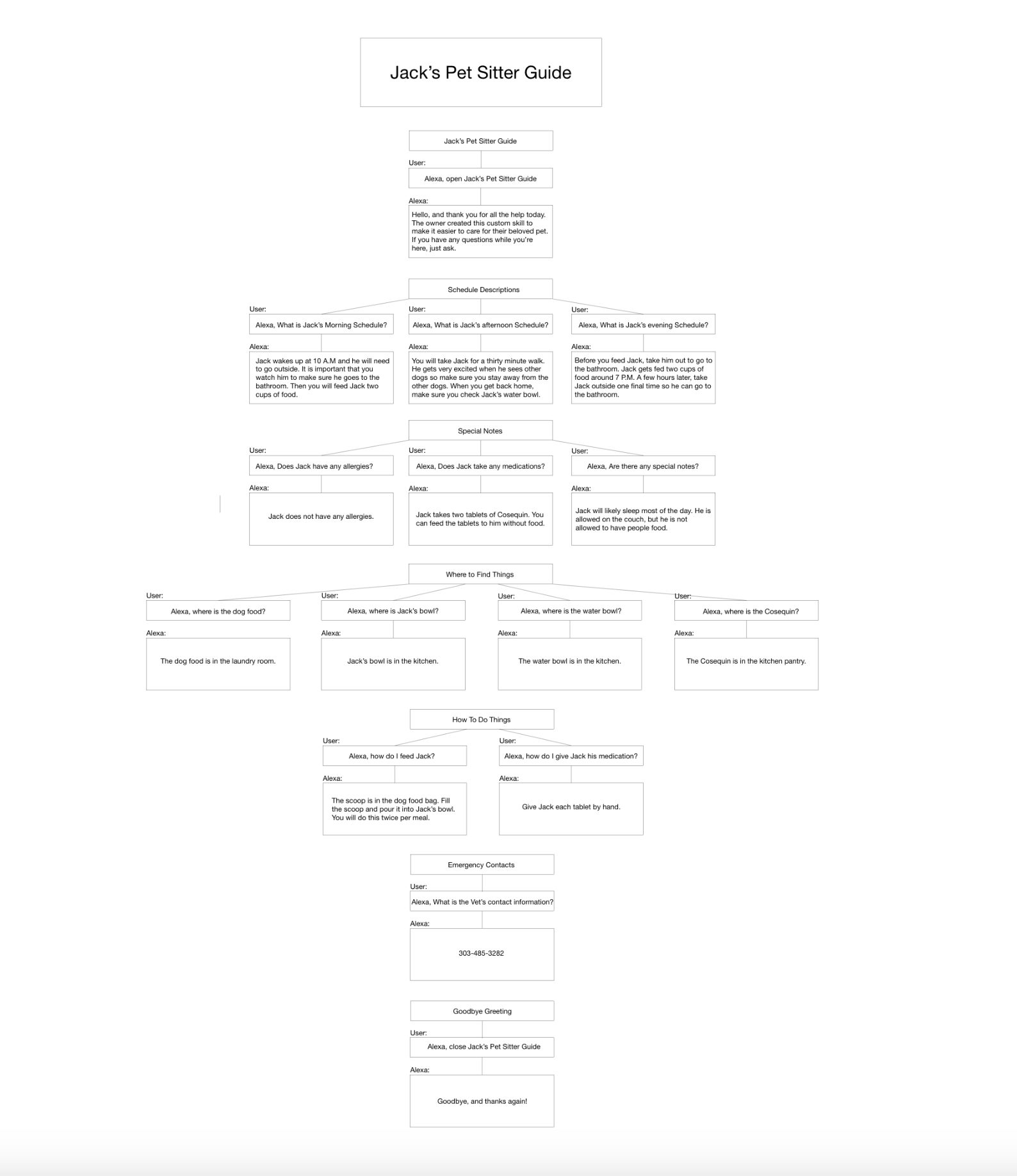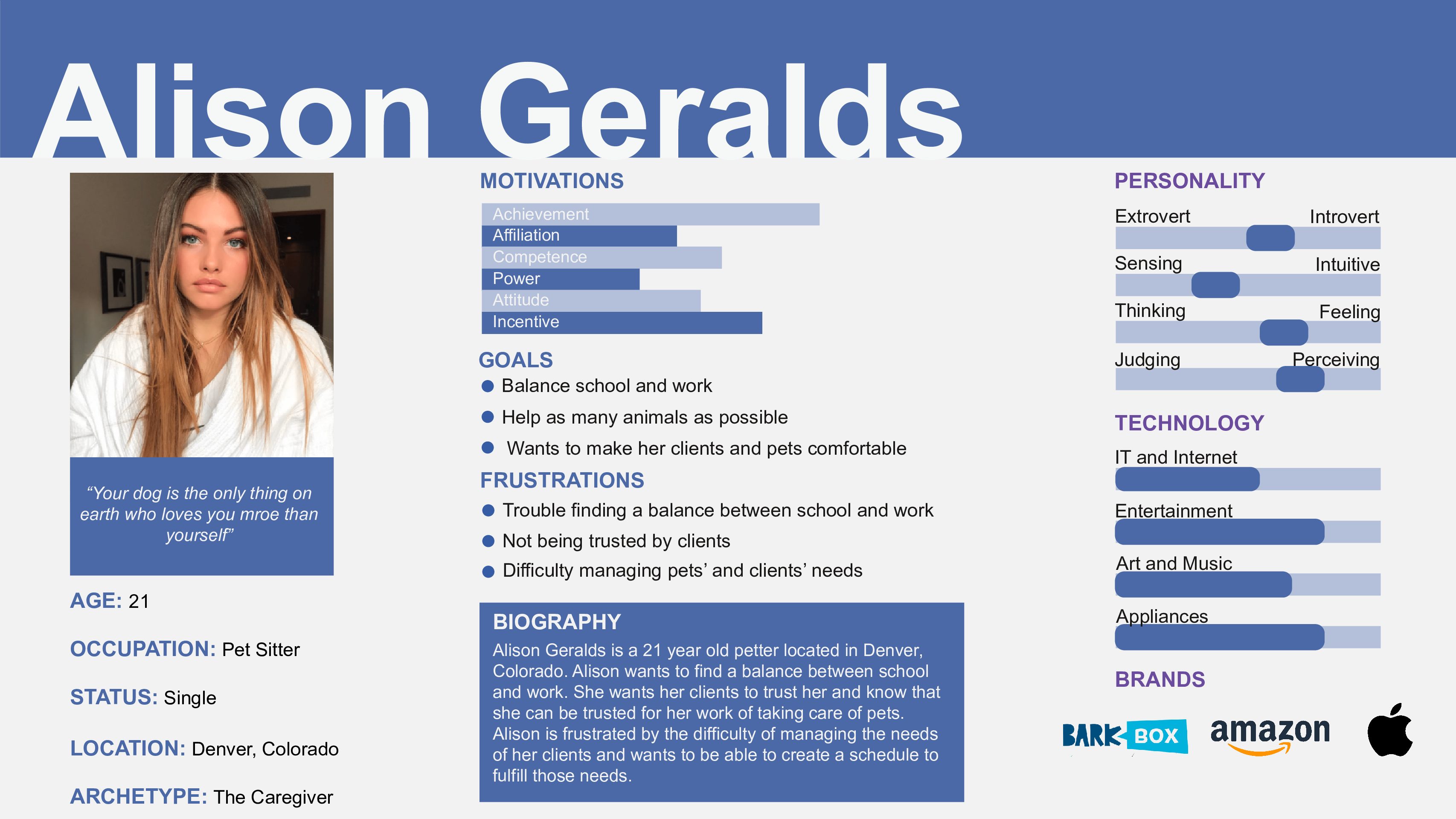Alexa Skill- Jack's Sitter Guide
Case Study
What is an Alexa Skill?
Alexa Skills are similar to phone apps. The user uses a skill similarly to how they would use a smart phone app, however, the user uses their voice instead of a touch screen. To install a skill, a user would need to install the Alexa app on their phone or computer. Alexa Skills are used through Amazon VUI products, such as the Echo. Amazon’s Alexa can perform a wide range of tasks, such as setting timers, playing music, reading stories, and answering questions, all through using its voice (Charlton 2020). Amazon makes Alexa Skills easier to use, because the user doesn’t have to code the skill if they don’t want to. Alexa Skills are easy to use, and the user will tell Alexa to enable a skill or disable a skill while speaking through the voice assistant device.
What Did I create?
The Alexa Skill I’ve created is called, Jack’s Sitter Guide. The skill is used by a dog sitter who wants to know how to take care of the dog they are pet sitting. This skill is helpful, because the information cannot be lost, and it is very informative in how to perform tasks or provide information. The pet sitter will say, “Alexa, open Jack’s Sitter Guide”. Alexa will open the skill so the pet sitter will be able to ask questions such as, “What is Jack’s morning/afternoon/evening schedule?”. The Skill I’ve created will allow the pet sitter to thoroughly take care of the dog and become aware of the dog’s needs.
What Went Wrong and What Worked
Originally when creating an Alexa Skill, I had a different idea in mind. I wanted to create a storytelling skill, but I had a couple challenges along the way. The storytelling skill was difficult to use, because I kept getting errors in my story. I moved on to create the pet sitting skill and had a much easier time doing so. I created the pet sitting skill by first mapping out everything I wanted to do in Adobe XD. I created a flow chart that would be simple and straightforward for the user. Once I’ve finished the flowchart, I moved onto my persona. The skill is for pet sitters; therefore, I knew who my target audience was going to be. As a pet sitter myself, I was able to reference age range in order to have a correct persona. After the persona I moved onto the creation of the Alexa Skill. The blueprint was simple and easy to use, and I filled in information based on my dog. The blueprint was separated into several sections: Schedules, special notes, where to find things, how to do things, and emergency contacts. Each question for the separate sections can be asked out of order, making it easy for the user to use. I created the design of the speech patterns to be blunt and simple-worded answers and questions. I wanted the speech patterns to be non-descriptive, which is why I broke the questions from the flow chart into certain sections. I refined the skill by correcting spelling and speech errors. Overall, Alexa is a really smart and well-designed VUI device. There wasn’t much to refine, but I would definitely add questions that are worded differently so Alexa will be able to answer anyone’s questions.
Charlton, Alistair. (2020, January 27). What are Amazon Alexa Skills? Gear Brain. Retrieved from, https://www.gearbrain.com/what-are-amazon-alexa-skills-2471456002.html


Jack’s Sitter Guide Video
Usability Study Analysis
Throughout the process of creating my Alexa Skill and having users test it out, I wanted to learn about the way people speak to the voice assistant. When testing out the skill myself, I noticed I could only ask questions that were registered for Alexa to answer. For example, “What is the contact information?” and “What is the emergency contact?” are the same questions but asked differently, however, Alexa could only answer one of those questions when I tested it out on her. I wanted to see if there were any changes I needed to make or add to the skill. I also wanted to see if Alexa could understand the way people speak, as I had to speak to the device twice when asking one of the questions. I wanted to see how I could improve the answers and if I needed to change the wording of the questions around so they would make more sense. I also wanted to understand which information is useful and which is not. I wanted the user to tell me if the questions were too robot-like and if they were too informal or should perhaps be more informal. I also wanted to learn if there is anything the user doesn’t understand that I needed to make clearer in Alexa’s responses.
I conducted 5 user testings for Jack’s Sitter Guide. The tasks were to speak the following questions.
- “What is Jack’s morning schedule?”
- “What is Jack’s afternoon schedule?”
- “What is Jack’s evening schedule?”
- “Does Jack have any allergies?”
- “Does Jack take any medication?”
- “Are there any special notes?”
- “Where is the dog food?”
- “Where is Jack’s bowl?”
- “Where is the water bowl?”
- “Where is the Cosequin?”
- “How do I feed Jack?”
- “How do I give Jack his medication?”
- “What is the contact info?”
Qualitative Analysis
Each of the five users tested my skill and provided descriptive information on what they believed could change. I found the users were able to easily ask Alexa the questions but only because I had written them down. The users compared my skill to other pet sitting skills and found that mine was more accessible due to having the questions written down for them to ask. I also found that Alexa speaks a bit too fast and that I should add more punctuation for the user to understand Alexa better without her speaking too fast. I did learn that Alexa is a bit too robot-like, and I should add more personality. I found that there was unnecessary wording when Alexa answered some of the questions. For example, a user would ask, “what is the afternoon schedule?” and Alexa would answer, “okay, the afternoon schedule is…”. Another thing noticed from each of the five users is that they thought the skill had fluidity and the skill was easy to understand.
Quantitative Analysis
3 of 5 users thought the answers were too generic
3 of 5 users had two questions that didn’t work them
2 of 5 users were able to ask and receive answers for all the questions
2 of 5 users thought there was too much information in the introduction
5 of 5 users thought the skill was easy to use
Project Reflections
What I found most challenging about creating this skill was the speech patterns. Originally, my questions were too descriptive. I wanted the user to be able to ask Alexa a question in any way possible, but Alexa only answers questions that are written in the skill. In the future, I would love to learn more about Alexa’s speech patterns in order to be able to ask questions worded differently and still get the same result.
After creating my Alexa Skill, I am most proud of completing the skill and being able to successfully make a working Alexa Skill. Because I switched Alexa Skills, it was very challenging in the beginning. I gave up on the storytelling skill, because the errors in the storytelling speech became very frustrating. I was happy to switch skills, because storytelling isn’t my passion, and even though the pet sitter guide skill was more challenging through speech, I was proud of the end result.